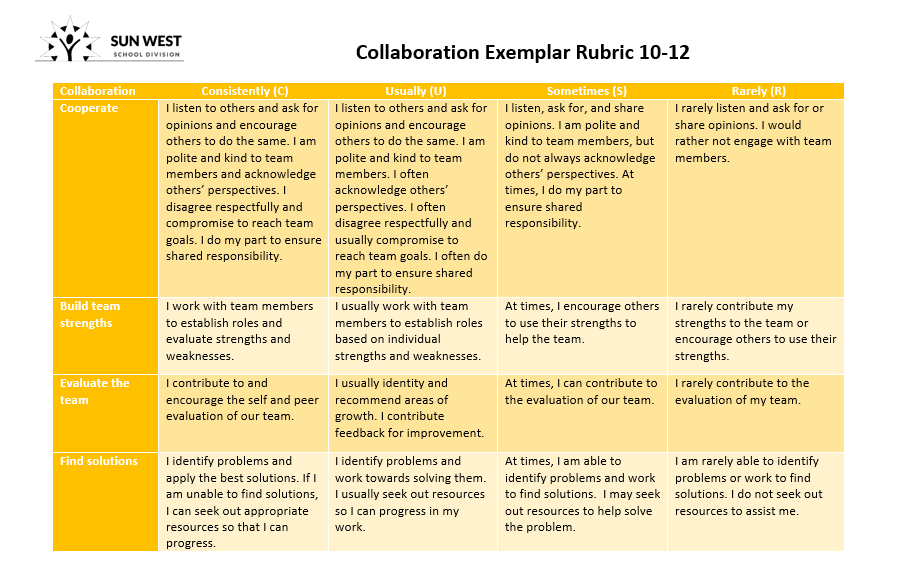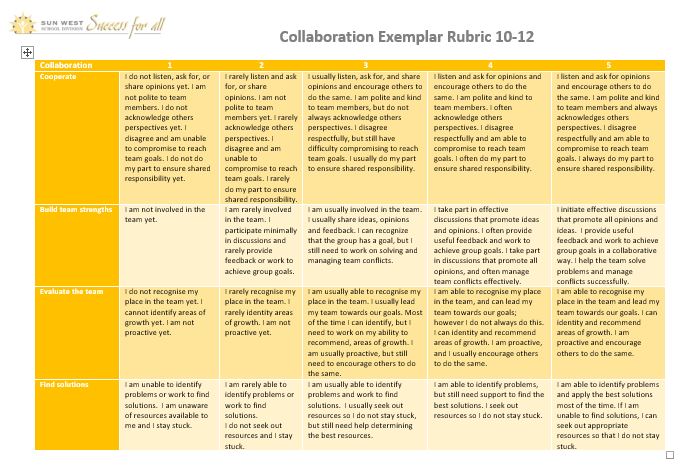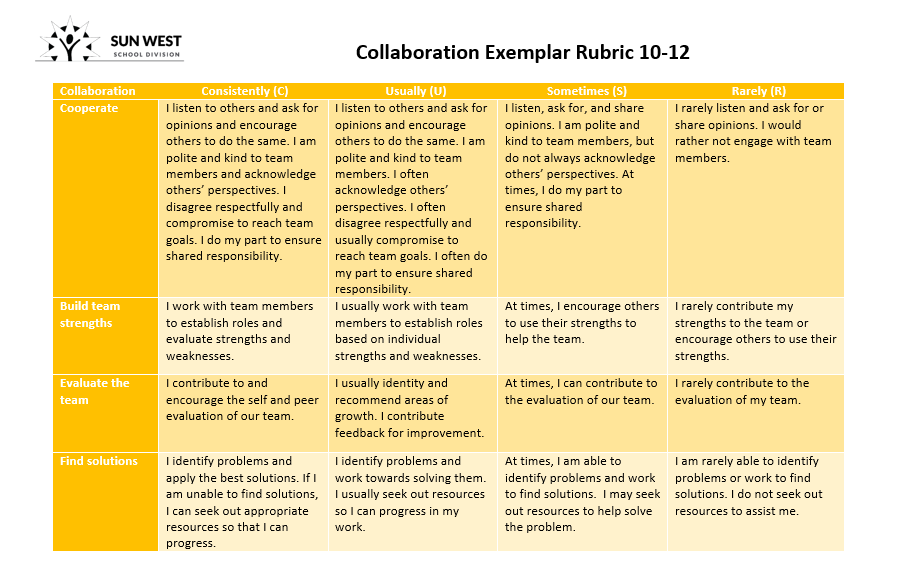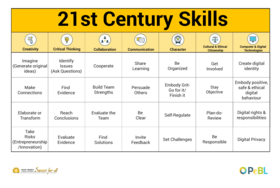Collaboration Guidebook - 10-12 (High School) Sun West
Collaboration High School 10-12
Purpose
Collaboration is increasingly mentioned as an important educational outcome and most models of 21st century education include collaboration as a key skill. The value of collaboration has been assumed for many years, and over the past two decades we have seen leading businesses and organizations move to facilitate team building and team-based work. The ability to work effectively with others has become a critically important skill for career and life success.
Here is what we know about collaboration and collaborative learning:
- Emphasis on collaboration remains traditional, reflecting older models of interaction
- Use of technology does not always boost collaborative learning or improved digital literacy
- Students learn best from a mix of individual and group-based learning experiences
- Collaboration can enhance the development of critical thinking skills
- Four categories of assessment exist for evaluating collaboration as a process and outcome for both groups and individuals
- Collaborative problem solving is an area to watch with new assessments
Collaboration. P21 Partnership for 21st Century Learning. http://www.p21.org/our-work/4cs-research-series/communication. Web. May 7, 2018
Why it’s important: Students of the digital age are social by nature. They text, post, update, share, chat, and constantly co-create in technological environments with each other. When they are unable to do this in school, they become disengaged and unattached to their learning. Connection and collaboration with others are essential not only to their learning but their mental and emotional health. It is a skill that educators must exercise with them regularly, and understanding Collaboration Fluency will assist with this.
https://globaldigitalcitizen.org/collaboration-fluency-video/
Watanabe-Crockett, Lee. The Critical 21st Century Skills Every Student Needs and Why. Global Digital Citizen Foundation. https://globaldigitalcitizen.org/21st-century-skills-every-student-needs. Aug 2 2016. Web May 6, 2018
Explicit Teaching
To be able to learn and grow in 21st Century Competency understanding, it is important to teach each skill and let students experience what each skill looks like as well as how you can grow in each area. Caution: by simply saying the word "communication or collaboration...etc" students may not get a full understanding of each skill. Explicitly teaching and utilizing skills in different ways is what will ultimately promote deep understanding and growth in 21st Century Competencies.
Timeline Suggestions for Explicit Teaching
The document below provides a year plan to teach each of the 21st century skills. It is beneficial to have an explicit teaching plan to ensure each skill is taught; however skills should also be reinforced as much as possible throughout class time.
Lesson Plans
Cooperate
Cooperation Ideas:
There are many activities that can support students struggling to "cooperate". Here are a few ideas:
1. Using Tech Tools, have students create posters for the school around the concepts of cooperation, collaboration, and teamwork.
2. Together, watch and discuss videos that have both positive and negative cooperation. See sample videos below. Use exit slip as formative assessment:
https://www.youtube.com/watch?time_continue=19&v=8Amu3UBj-qw
https://www.youtube.com/watch?v=ZnjJpa1LBOY
https://www.youtube.com/watch?v=fUXdrl9ch_Q
3. Create anchor charts of what participating and cooperating in a group looks like. Establish group cooperation/collaboration norms.
Build Team Strengths
Build with Team Strengths Ideas:
The following ideas/activities are for students struggling to "Build with Team Strengths".
Part of being able to build team strengths means initiating and promoting effective discussion, providing and accepting useful feedback, and solving and managing conflicts successfully. See below for ideas:
1. Steven Covey’s- 7 Habits of Highly Effective People talk about “Emotional Bank Account”. A good way to talk to students about being a good group member and building on everyone’s strengths.
Lots of free activities & YouTube videos available for more information and activity ideas.
https://www.youtube.com/watch?v=qktDB08EBCM
2. Create sentence starts for students to brainstorm in creative ways to have discussion. “Accountable Talks”.
Link to some free bookmarks from Teachers Pay Teachers:
https://www.teacherspayteachers.com/Browse/Search:accountable%20talk%20bookmarks
3. Assigning student roles for collaborative group work ensures that all students are contributing meaningful information. Such roles might include leader, recorder, and/or monitor. Having a direction in discussion makes student collaboration time focused and worth it! Use the "Discussion Record" below as a guide:
Discussion Record
Evaluate the Team
Evaluate the Team Ideas:
The following ideas/activities are for students struggling with "Evaluate the Team".
Part of being able to evaluate the team means being able to recognize our place in the team, lead the team to their goals, recommend areas of growth, and be a proactive member of the team. See below for activity suggestions:
1. Group and Self Assessment Rubrics to open up discussion. Co-create partner assessments according to the group norms you agreed upon.
2. Peer Assessment Rubric - "Praise Question Polish"...this rubric invites students to give positive feedback and suggestions for improvement for peer work in three parts! See below for a sample:
Self-evaluation tool:
Read Write Think Group and Self Evaluation Tool
3. Teach kids how to celebrate and recognize the good work others have done. Brainstorm a list of ways to celebrate and than you team.
4. Student Exit Slips that assess their abilities as group members can be useful such as:
Sample Student Exit Slip
How did your part in group work today compare to your part last day?
What is one thing about your part in group work you are proud of?
What made you successful or uncsuccessful?
How could you improve next time?
What did you recognize in your peers that worked for them?
If you could applaud someone in this class for their growth and success in group work, who would it be and why?
Collaborative Group Rubric
Find solutions
The following activities are for students struggling with "Find solutions":
Part of being able to find solutions means being able to identify problems and apply the best solutions, as well as seek out resources as needed to remain unstuck. See below for activity ideas:
1. Teach Problem Solving and Mindset:
a. IDEO Company - IDEO is a global design company that creates positive impact through design.
"Field Observatoins with Fresh Eyes".
b. Design Thinking is an approach to addressing challenges in a thoughtful and fun way, where you get to apply the 4Cs -- collaboration, creativity, critical thinking, and communication - to your own work as you develop new solutions for your classroom, school, and community.
"Design Thinking for Educators".
"What is Design Thinking"
"10 Ready to Borrow Project Ideas"
2. Have students brainstorm and practice effective problem solving methods. The following site gives a student perspective on the benefits of teaching problem solving:
"4 Tips Teaching Problem Solving"
3. Share with students and discuss the ideas on the SNOT poster.
Integration of Skills
Intentional integration of 21st Century Competency language in all day-to-day activities supports the development of routine reflection, skill use, and growth in support of curricular knowledge acquisition.
Why?
If we do not intentionally integrate 21st Century Competency connections into our learning environments, it is easy to forget about them. As the language becomes routine, growth in skills can and should be explored regularly. Ultimately the 21st Century Competencies are the skills needed to be successful in all day-to-day activities as well as future career opportunities. By being intentional in integrating the language and skill use in all aspects of learning, understanding of the skills can be applied and reflected upon to look for areas of potential growth and application.
How?
Once skills have been explicitly taught, integration of 21st Century Competencies can be achieved by connecting skills to all curricular areas, participating in pre-and post reflections (allowing students to predict which skills will be needed and subsequently which skills need to be worked on) and the use of 21st Century Competency rubrics to track growth.
Example: by using learner profile data, students can reflect on which skills they need to employ for a particular activity and based on this information, choose group members that have strengths or challenges in those skill areas.
Examples
When integrating 21 Century Competency language in all areas of learning consider the following curricular connected resources.
As you use similar resources in your own learning environment, how can you relate them back to growth and understanding of the 21 Century Competencies?
In ELA
In Math
Teachable moments
Whenever a question, situation, comment or activity that involves a connection to a 21 Century Competency arises, take a moment to talk to students about it. Discussing skills, how they integrate into everything you do in life makes the reflection on the importance of skills a habit. This habit will instill a growth mindset around developing skills to their fullest potential. Teachable moments can be as short as 20 seconds. Make it your habit and it will become theirs!
Tracking Growth
When considering 21st Century Competency application, it is essential for both the teacher and the student to track growth. There is clear potential for growth in skill use throughout our lives. To ensure growth and understanding of application is taking place, we can easily track progression using rubrics, checklists, and self-assessments.
Formative Assessment
Formative assessments of 21st Century Competencies include anecdotal documentation, self-assessments and rubric check-ins. These formative assessments provide snapshots of growth throughout the learning process and allow goal setting to take place.
See below for Self-Reflection and Goal Setting Documents:
Assessing Growth
Summative Assessment
Exemplar Rubrics
Either share the rubric with your students, or just share the categories and come up with a rubric that is personalized for your class. Post the rubric somewhere that will ensure it is referred to often.

Collaboration 10-12

Collaboration 10-12 Exemplar Rubric
Co-creating Rubrics
Exemplar rubrics have been developed for K-5, 6-9 and 10-12. To connect fully with students in their understanding of skill application and growth, a recommendation would be to re-write the rubric with the students to include their understanding of the skill, goals for integration in learning and commitment to the skill development.
Resources
Setting the Norms for Group Work and Collaboration. This website has posters, and various student inventories and assessments for self-reflection and group reflection.
Sun West Resource Bank High School Collaboration Resources
Print based
Sun West Original Print Based Collaboration Guidebook: Collaboration Guidebook
Collaboration Fluency Quickstart Skills Guide - Login to the Global Digital Citizen Foundation to download the guide.
Videos
Interactive
Educational Articles
Web Sites
Thinking Collaborative - This website has posters and various student inventories and assessments for self-reflection and group reflection.
Critical Thinking and Collaboration Activities - A sample of the many different types of activities to build a collaborative classroom culture.
Edward des Bono’s- Six Thinking Hats is a simple, effective parallel thinking process that helps people be more productive, focused, and mindfully involved. A powerful collaboration tool set, which once learned can be applied immediately! You and your team members can learn how to separate thinking into six clear functions and roles. Each thinking role is identified with a colored symbolic "thinking hat." By mentally wearing and switching "hats," you can easily focus or redirect thoughts, the conversation, or the meeting. Many resources are already created for this strategy. Do a quick google search and many already made activities are ready for you. For example:
http://www.debonogroup.com/six_thinking_hats.php
https://www.youtube.com/watch?v=UZ8vF8HRWE4

Collaboration 10-12
